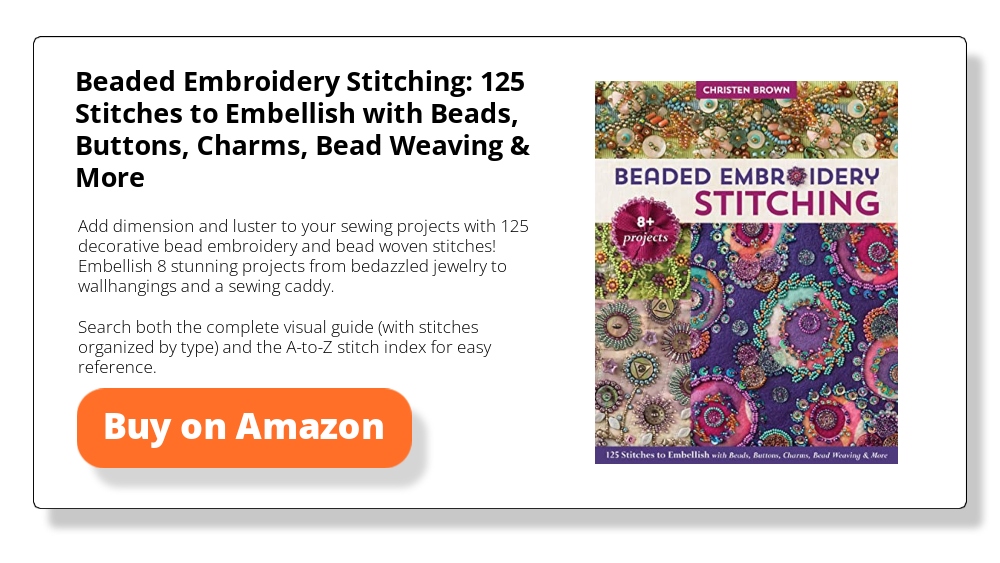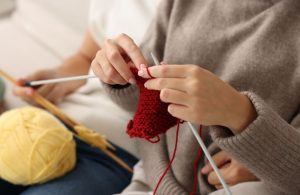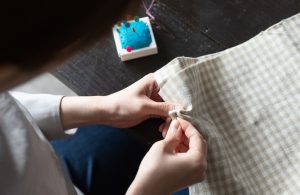Last Updated on October 13, 2025 by Team Ideas24
Embroidery has stood the test of time as a timeless art, adding a touch of class and finesse to fabrics and textiles. But, there is an even more remarkable way to elevate your embroidery skills. Enter bead embroidery. This captivating and exquisite technique has taken the crafting world by storm.
With just a needle and thread, you can transform your fabrics into magnificent works of art. The options are endless – you can add a touch of luxury to your clothing and accessories, create stunning art, and exquisite jewelry, or even give your home decor a whole new look.
By deftly blending colors, sizes, and textures, you can unleash your imagination and craft awe-inspiring designs that speak to your inner artist. You can transform any fabric – from silk to cotton, even leather – into an enchanting work of art bursting with vibrancy and beauty.
Contents [show]
The Art of Bead Embroidery: Unlocking the Secrets of a Timeless Craft
This blog post will explore the basics of bead embroidery, including embroidery materials, techniques for stitching beads onto fabric, and tips for creating intricate designs. With the right guidance and tips, you can master the art of bead embroidery and enjoy the satisfaction of creating something unique and beautiful.

Bead Embroidery Materials
Bead embroidery is a glorious art form that has been practiced for centuries. It requires not just creativity and skill, but also the right materials to bring a vision to life.
Here are some materials that you will need to get started with bead embroidery:
- Beads—A wide variety of beads are available for embroidery, including seed beads, bugle beads, cylinder beads, and more. Beads come in different sizes, shapes, colors, and finishes, so it’s important to choose the right ones for your project.
- Embroidery thread – Embroidery thread stitches the beads onto the fabric. Choose a strong and thin thread to fit through the holes of your beads.
- Needles – You will need needles with small eyes to thread your embroidery thread through. Beading needles are the best option for bead embroidery as they are longer and thinner than regular needles.
- Fabric – Any fabric can be used for bead embroidery, but it’s important to choose a fabric that is strong enough to support the weight of the beads. Popular choices include cotton, linen, and silk.
- Embroidery hoop – An embroidery hoop is used to hold the fabric taut while you stitch. This makes it easier to work with and ensures that your stitches are even.
- Scissors – You will need a pair of sharp scissors to cut your embroidery thread and fabric.
- Bead mat – A bead mat is a soft surface that helps prevent your beads from rolling around while you work. You can also use a piece of felt or a towel as a makeshift bead mat.
- Glue – Sometimes, it is necessary to glue beads in place. Choose a glue that dries clear and will not damage the fabric or beads.
- Patterns or designs – You can find bead embroidery patterns online or in books. Alternatively, you can create your design by sketching it onto the fabric with a pencil.
These are the basic materials you will need to get started with bead embroidery. As you gain more experience, you will feel like experimenting with different types of beads, threads, and fabrics to create one-of-a-kind designs.

Bead Embroidery Foundation
Bead embroidery is a beading technique where beads are stitched onto a fabric foundation instead of being stitched to each other as in off-loom bead weaving or loom beading. This technique allows for greater design flexibility, as you can create intricate and detailed designs by layering beads and stitching them onto the fabric foundation.
There are many different types of bead embroidery foundation materials available, and the choice of which one to use will depend on the type of project you are working on and the desired outcome. Some common bead embroidery foundations include imitation leather or suede, fabric embroidery interfacing, and specialized products.
Imitation leather or suede provides a sturdy and durable foundation for bead embroidery, and its texture can add an interesting element to your design. Fabric embroidery interfacing is another popular option, as it provides a lightweight and flexible foundation that is easy to work with.
Specialized products are also available that are specifically designed for bead embroidery foundations. These include pre-printed patterns or designs on a fabric or paper surface or adhesive sheets that can be used to attach beads directly to the surface without the need for sewing.
Bead embroidery foundations can be found in a variety of craft stores, fabric stores, beading supply companies, and online bead shops. It’s important to choose a foundation material that will provide the support and stability necessary for your particular project, while also allowing for the flexibility and design possibilities that bead embroidery offers.
Try DIY throw pillows for couch and use bead embroidery techniques and see how fun and fulfilling it can be. It’s a great project, and truly rewarding as you get to add decorative touches to your home decor.
Bead Embroidery Lining
Bead embroidery lining is a technique that involves adding a layer of beads underneath the surface of your embroidery work. Not only does it create an intricate and detailed design, but it also adds a three-dimensional quality that truly brings your work to life.

Many different types of materials can be used as a lining for bead embroidery, and the choice of which one to use will depend on the specific project and the desired outcome. Some common lining materials include:
Plastic Milk Jugs
These are simple and inexpensive options for lining bead embroidery pieces. Cut a piece of the jug to the size and shape you need, and then stitch it to the back of the beadwork.

Brass Embroidery Blanks
There is a wide range of brass embroidery blanks that are specifically designed for bead embroidery. These blanks are pre-cut to specific shapes and sizes and are an excellent option for creating professional-looking finished pieces.
Felt
Felt is a popular lining material for bead embroidery as it is easy to work with, lightweight, and adds an extra layer of cushioning to the finished piece.
Felt comes in a variety of colors and thicknesses, which means that you can choose the perfect type of felt to suit your specific project. This allows for greater creativity and flexibility when it comes to designing and executing your bead embroidery projects.
Interfacing
Fabric interfacing can also be used as a lining for bead embroidery. It adds stiffness and structure to the beadwork and is available in a range of weights and stiffness levels.
When selecting a lining material for your bead embroidery project, it’s important to consider the level of stiffness and structure you want to achieve, as well as the desired durability of the finished piece.
Experimenting with different lining materials can help you find the perfect solution for your specific project.
Bead Embroidery Backings
Bead embroidery is a beautiful and intricate art form that requires patience, skill, and attention to detail. One of the essential components of achieving a stunning bead embroidery piece is using the right backing. Bead embroidery backings are the groundwork, providing a stable surface on which to create your beaded design.

Whether you prefer to work with felt, interfacing, stabilizers, or other materials, the right choice of bead embroidery backing can take your work to the next level.
Felt is a popular choice for bead embroidery backing as it provides a soft, cushioned surface for your beadwork and is available in a wide range of colors. Interfacing is another common choice, as it provides a stable base for your beadwork and can be easily cut to size and shape.
Stabilizers are specialized products designed specifically for bead embroidery and provide a firm yet flexible backing that is ideal for intricate designs. When choosing a bead embroidery backing, it’s important to consider the level of stiffness and support you need for your particular project, as well as the desired texture and appearance of the finished piece.
Different materials can also affect the way your beadwork looks and feels, so experimenting with a variety of backings can help you achieve the perfect result.
Beading Thread
Bead embroidery is an art form that has captivated people’s imaginations for centuries. One of the most essential things that makes it possible is the beading thread. This vital component of the bead embroidery process allows designers to bring to life stunning and intricate designs on various fabrics.
The beading thread acts as a lifeline that holds the beads in place and helps to form beautiful patterns. But, beads can be quite heavy, especially when used in large quantities, and as such, they can put a significant amount of strain on the thread. This is why it’s important to choose a strong and durable thread that can withstand the weight and pressure of the beads.
There are several different types of beading threads available, each with its unique characteristics and strengths. Some of the most commonly used threads include nylon, silk, and polyester. Nylon is known for its strength and durability, while silk is favored for its smooth and luxurious texture. Polyester is often used for its affordability and ease of use.
The type of thread you choose will depend on the specific needs of your project. If you’re working with heavy or large beads, you can want to choose a thread that is strong and durable, while if you’re working with delicate or intricate designs, you can prefer a thread that is finer and more flexible.
Beading Needles
Bead embroidery is a beautiful craft that can bring so much joy to those who practice it. One important tool that every beader needs is a good set of beading needles. These needles are specially designed to easily slide through small beads without damaging them, allowing bead artists to create intricate and detailed designs.
As you thread your beading needle and begin to weave your beads together, you will feel a sense of calm and focus that comes from working with your hands to create something beautiful. No matter your skill level, there are always new beading techniques to learn and endless possibilities for design. Be confident and creative with your beading needles, and watch as your bead embroidery comes to life before your eyes.
Beads for Embroidery
Bead embroidery is a magnificent craft that merges traditional needlework with the timeless beauty of beads. It is a delightful way to add texture, depth, and brilliance to your embroidery projects. With beads for embroidery, you can create intricate and stunning patterns, bring images to life, and add a touch of glamour to any fabric.
Beads come in a wide range of shapes, sizes, and colors, and can be used to create intricate designs and patterns that bring fabrics to life. They can be used to create intricate borders, add accents to clothing or accessories, or create an entire piece of beadwork that stands alone as a work of art.
One of the advantages of using beads for embroidery is their versatility. They can be used on a wide range of fabrics, from delicate silks to heavy denim, and can be incorporated into any number of intricate designs or patterns.
Summary
To summarize, bead embroidery is a wonderful craft that allows both beginners and experienced artists to create beautiful and unique designs. With a wide range of materials available and countless design possibilities, bead embroidery is a versatile and rewarding hobby that can be enjoyed by anyone.
Whether you want to create beautiful jewelry, embellish clothing, or add intricate detail to home decor, there are limitless choices with bead embroidery. With the right knowledge provided here, and with patience, practice, and a little bit of creativity, you can master the art of bead embroidery and enjoy it for years to come.




















